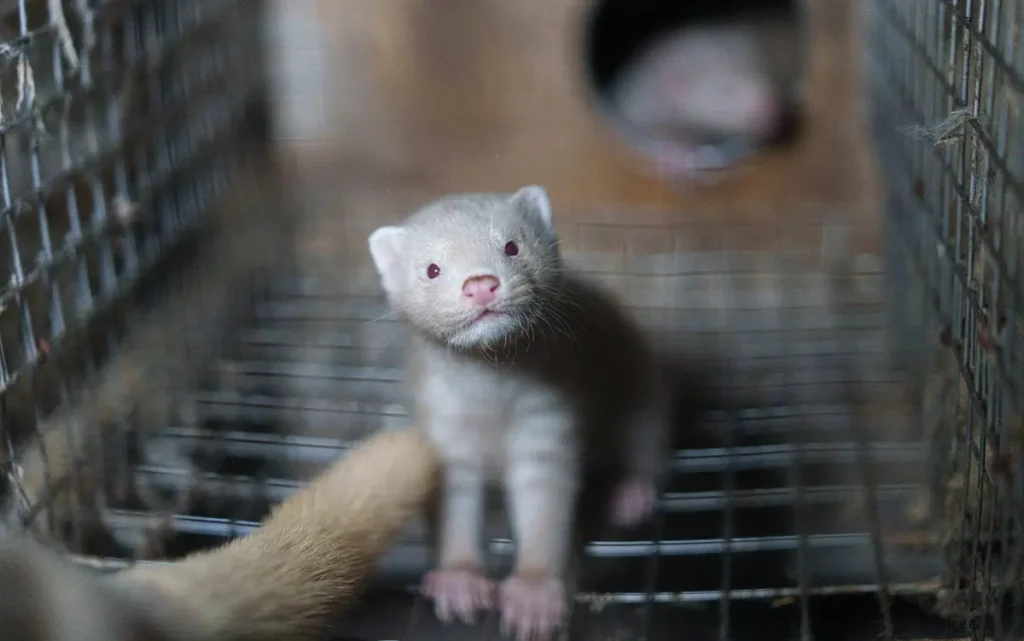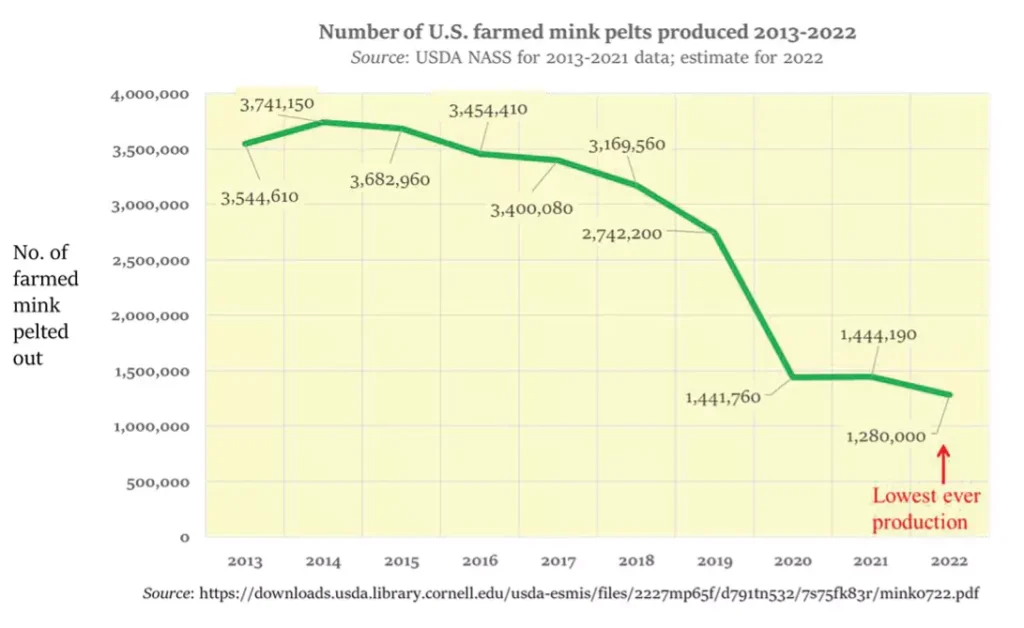
National Mink Farming Ban Introduced as Evidence Implicates Mink Farms in Spread of Deadly Bird Flu Virus
- Wayne Pacelle
Today, Congresswomen Nancy Mace, R-S.C., and Rosa DeLauro, D-Conn., renewed their effort from last Congress (2021-22) to ban mink farming in the United States. Their bill comes in the wake of a long-term and irreversible collapse in the domestic fur market in the United States, along with documented evidence that mink farms have unique viral spillover potential to humans, including mutated forms of H5N1 (“bird flu”) and COVID-19.
Minks are territorial, solitary, carnivorous animals, and confined on factory farms, they are trapped in cages where they routinely attack and kill others of their kind. No luxury garment is worth this kind of cruelty, especially since there is no longer any domestic market for it. These appallingly inhumane and dangerous conditions cry out for a change in the law.
Footage from an investigation in Poland by the animal welfare group Open Cages is horrifying, providing vivid evidence of aggression and cannibalism. It’s not a matter of improving animal husbandry — these wild animals simply cannot be safely and humanely housed in cages on any meaningful commercial scale.
At our urging, Congress took up the issue in 2021 because minks were the first species shown to transmit SARS-COV-2 across the species barrier to human beings. By continuing to keep these wild animals in stressful, unsafe, and overcrowded conditions, we are inviting viral hazards, says veterinarian and infectious disease expert Jim Keen, D.V.M., Ph.D., director of veterinary sciences for the Center for a Humane Economy.
Now there’s an even more ominous threat than COVID-19 mutations. Among the viruses mink can contract and spill over to other species is a deadly form of bird flu. An H5N1 mink mutant strain killed more than 200,000 farmed mink on six farms in Spain and Finland in 2022-23. This bird flu strain has killed 458 of 873 of the people it’s infected — a case fatality rate of 53%, much higher than any known influenza virus, including the infamous 1918 Spanish Flu that killed 50 million people. In short, if it mutates at a mink farm in the U.S. and becomes more transmissible, this new H5N1 strain would become a public health catastrophe of nightmarish proportions.
“If SARS-CoV-2 could design its perfect habitat, it might closely resemble a mink ranch: a highly stressed, immuno-suppressed inbred host with thousands of other mink kept in very small cages,” said Dr. Keen, a former top U.S. Department of Agriculture scientist. “This environment maximizes chances for infections and mutations. H5N1 is far more serious a threat to humanity than COVID-19 variants.”
The legislation, known as the MINKS in Narrowly Kept Spaces (MINKS) Are Superspreaders Act (H.R. 7670), is led by Mace and DeLauro, and cosponsored by Veronica Escobar, D-Tex., Brian Fitzpatrick, R-Pa., Madeleine Dean, D-Pa., Jeff Van Drew, R-N.J., Paul Tonko, D-N.Y., and Lance Gooden, R-Tex.
The Mace-DeLauro MINKS Are Superspreaders Act prohibits the possession, transport, and sale of captively raised mink for fur production. In the 117th Congress (2021-22), the House of Representatives passed a very similar measure led by Reps. DeLauro and Mace as an amendment to the COMPETES Act, but it was dropped from the final legislative package.
In 2023, mink production is expected to sink below 1 million animals for the first time in decades, with only 50 farms operating in the United States. In 1966, there were 6,000 mink farmers pelting 6.2 million animals. American mink farms today are unprofitable, unregulated in some states, and kept afloat by government subsidies.
 Production statistics from 2013-2022 show an industry in decline as domestic use evaporates and concerns about zoonotic threats increase.
Production statistics from 2013-2022 show an industry in decline as domestic use evaporates and concerns about zoonotic threats increase.
The collapse of demand for mink has been accelerated by a massive worldwide SARS-CoV-2 epidemic in farmed mink that has paralleled the human COVID-19 pandemic starting in 2020, with outbreaks on at least 450 mink farms in 13 countries in Europe, Canada, and the United States. Only humans and mink contract the virus in large numbers and can spill it back to other species — with more than 21 million captive mink (including culling) and more than 7 million people perishing directly as a result of the pandemic. You can read more about this in Animal Wellness Action’s new fact sheet here.
U.S. producers sell their pelts to China, meaning that U.S. communities face the threat of viral transmission to produce a luxury product for a thin sliver of the Chinese population. Mink farms operating in the United States might be best described as viral time bombs planted in dozens of locations, with negligible economic benefits but potentially disastrous consequences for the homeland.
We know that mink are the only non-human animals who are bilateral transmitters of COVID-19. We also know they are now infected by H5N1 and could spill that far more deadly virus into the human population. Yet we continue to house them on factory farms to generate a luxury product that few people want or need. The MINKS Are Superspreaders Act should be an urgent priority for a nation concerned about the intertwined problems of wildlife exploitation and emerging pandemics.
Dear reader: If you support substantive policy work to protect animals, please consider donating to Animal Wellness Action today. You can give any amount one time, or make it a monthly gift, as many of our supporters do. Thank you for helping us fight for all animals. Please go here to make your contribution.
Photo credit: Jo-Anne McArthur / #MakeFurHistory / We Animals Media